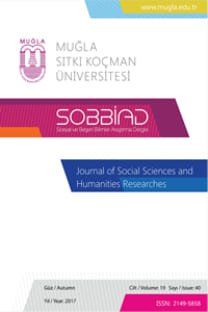Nicole Krauss’un Aşkın Tarihi Adlı Romanında Tarihi İzlekler
Modern edebiyatta önemli Yahudi Amerikan yazarlarından olan Nicole Krauss Yahuditoplumundaki yabancılaşma, yalnızlık ve göç konularına değinir. Başarılı romanı olanAşkın Tarihi II. Dünya Savaşı süresince Holokost’a maruz kalan ve etkilerini hissedenYahudi karakterle ilgilidir. Tarihle bütünleşen bu karakterler gerçek hayattakiinsanlardan ve olaylardan esinlenmiştir. Krauss romanında postmodern teknikleri dekullanır. Örneğin iç içe anlatım tekniği okuyucuya romanın kurgusal mı yoksa gerçek miolduğu kuşkusunu doğurur. Romanın başkahramanı Amerika’da yaşayan Leo Gursky Naziler yüzünden memleketinden ve kız arkadaşından ayılmak zoruna kalan ve sevdiğikıza göre fantezi ile gerçeklik arasında sıkışıp kalan üç romanı kaleme alan yaşlı biradamdır. Krauss romanında tarih ile bugünü birbirine katan kurgusal bir dünya yaratır.Birçok eleştirmen de bu romanla ilgilenmiştir. Örneğin Lang romanı üç öbekleözetlemiştir: “tarih, ihtiyatlı eleştirel bir toplum ve tarihsel olaylarla kendileri arasındahayali bir bağlantı özümseyen çağdaş bir kitle” (2009: 43). Diğer bir taraftanIndependent gazetesi ise Krauss’un geçmişini kullanarak gerçekleri yazdığını ifade eder:“New York ve Kudüs, Oxford ve Londra arasında gidip gelen Krauss geçmişten gelenbirçok hikayeyi yeni bir gerçeklikle yaratmak adına birbiriyle nasıl ilişkilendireceğininyollarını arıyor” (2011: 30). Bu bağlamda yazarın tarihle olan ilişkisi azımsanamaz. Buçalışmada tarih ve karakterler üzerindeki tarihsel izlekler tartışılacaktır.
THE INSIGNIAS OF HISTORY IN NICOLE KRAUSS’S THE HISTORY OF LOVE
Nicole Krauss, a distinctive Jewish American writer in modern literature, concerns about alienation, isolation, and emigration in Jewish society. Her successful novel, The History of Love deals with Jewish characters exposed to the Holocaust during the World War II. All characters directly or indirectly possess the marks of history, which is very crucial issue among Jewish writers. Coalesced with history, the characters are inspired from the real people and incidences. Krauss uses postmodern characteristics in her novel. For instance, the synchronistic narration blurs the readers mind by hesitating whether it is fiction or reality. The protagonist of novel, Leo Gursky living in America is an old man leaving his homeland and girlfriend because of Nazis and writing three novels which stuck between reality and fantasy according to his lover. Krauss creates a fictional world intertwining the history and present in the novel A great number of critics deals with the novel. For instance, Lang summarizes the novel with three phrases: “history, a wary critical community, and a contemporary audience longing for an imaginative connection between themselves and the historical event” (2009: 43). On the other hand, the Independent purports that Krauss authors the reality by using her past: “Moving between New York and Jerusalem, Oxford and London, Krauss looks at how multiple stories from the past are stitched together to create a new reality” (2011: 30). In this sense, the writer’s relationship with history cannot be abnegated. In this study, the history and the marks of history on characters will be argued.
___
- Bayer, G. (2010). “After Postmemory: Holocaust Cinema and the Third Generation” Shofar: An Interdisciplinary Journal of Jewish Studies V(28/4) 116-132
- Bellin, R. (2007). “Retrospection and Prophecy in the Structure of "Mad Love” Journal of Modern Literature V(30/2) 1-16
- Codde, P. (2011). “On the Problematic Omniscient Narrator in Nicole Krauss’s THE HISTORY OF LOVE” The Explicator V(69/1) 48–50
- Franklin, R. (2005). “Surgings” The New Republic V(May 16) 39-41
- Krauss, N. (2005). The History of Love London: Penguin Books
- Krauss, S. (1894). “The Jews in the Works of the Church Fathers. VI” The Jewish Quarterly Review V(6/2) 225-261
- Lang, J. (2009). “The History of Love, the Contemporary Reader, and the Transmission of Holocaust Memory” Journal of Modern Literature, V(33/1) 43-56
- Royal, D. P. (2007). “Tugging at Jewish Weeds: An Interview with Steve Stern” MELUS V(32/1) 139-161
- Sayers, V. (2011). “Great House” Commonweal 28 Jan.
- The History of Love 7 March 2011 NEW STATESMAN 43
- Weisel-Barth, J. (2013). “The Fetish in Nicole Krauss' Great House and in Clinical Practice, Psychoanalytic Dialogues:” The International Journal of Relational Perspectives, V(23:2) 180-196
